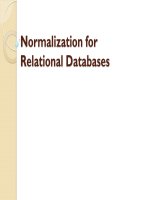Distributed Database Management Systems: Lecture 21
Bạn đang xem bản rút gọn của tài liệu. Xem và tải ngay bản đầy đủ của tài liệu tại đây (70.44 KB, 31 trang )
Distributed Database
Management Systems
Lecture # 21
In the previous lectures
Fragmentation: One of the
possible way we can implement
a DDBS
Types of Fragmentation
• Horizontal Fragmentation
• Vertical Fragmentation
Types of Horizontal
Fragmentation
1.
2.
Primary Horizontal Fragmentation
Derived Horizontal Fragmentation
Vertical Fragmentation
Vertical Fragmentation is
relatively more complex.
Why ?
In today’s Lecture
Replication
Storing a separate
copy of database
at each of two or
three or more sites
• Advantages of
Replication
–Reliability.
–Fast response.
–May avoid complicated
distributed transaction
integrity routines (if
replicated data is refreshed
at scheduled intervals.)
–De-couples nodes
(transactions proceed
even if some nodes are
down.)
–Reduced network traffic at
prime time (if updates can
be delayed.)
• Disadvantages of
Replication
–Additional requirements
for storage space.
–Additional time for
update operations.
–Complexity and cost of
updating.
–Integrity exposure of getting
incorrect data if replicated
data is not updated
simultaneously.
• Therefore, better when
used for non-volatile data.
Replication
Architecture in SQL
Server
Replication uses a
publish-subscribe
model for distributing
data
Publication
A Publication is group of
related data and objects
that we want to replicate
together.
Publisher
A Publisher is a server
that is the source of data
to be replicated.
Subscriber
A Subscriber is a server
that receives the data
replicated by the
publisher.
• The Subscriber
defines a
subscription to a
particular publication
• A Distributor is a server
that performs various tasks
when moving articles from
Publishers to Subscribers.
• The actual tasks performed
depend on the type of
replication performed.
SQL Server
Replication Agents
Agents are the software
components used in
replication
Types Of SQL Server
Replication Agents
• Snapshot Agent
• Merge Agent
• Distribution Agent
• Log Reader Agent
• Snapshot Agent: Runs at least once
in all replicas
• Distribution Agent: performs
different activities, mainly distributes
publication to subscribers
• Log reader Agent: used in
transactional rep, reads log files of all
servers involved
• Merge Agent: Meld changes from
different servers made since last
snapshot
Push/Pull subscriptions;
depends where the
distributor is running.
Replication Models
Publ/Dist Sever
Central Publisher / Distributor









